- Getting around Lijiang. Dont stay in the Old Towns more than 2 days, there is nothing to do. KRISS Oct 9, 2013 05:46
- 2013 Beijing Temple Fair BENNYLAU Feb 26, 2013 03:29
- Malaysian traveling from KUL - LAX vis Shanghai PVG ZATI_DY Jan 3, 2013 20:15
Tales of Dragons & Waterfalls
- Views: 6809
- |Vote: 0 0
- |Add to Favorites
- |Recommend to Friends
The Hidden Dragon Waterfalls
The Hidden Dragon Waterfalls (藏龙百瀑) are located deep inside Tianmushan (天目山), a range of mountainous hills in the far south of Anji County, Zhejiang Province. Covering an area of 3 square kilometres, the scenic area climbs into a natural gully, following the rocky watercourse that creates many waterfalls, before emerging out onto the top of the mountain with spectacular views. The area is visited primarily for its natural beauty: the bamboo woodlands, abundant waterfalls and rocky gorge.
It is a “public bus to nowhere – followed by a long wait for a minibus” journey to the waterfalls, typical of less travelled routes in China. The second half of the journey in the minibus takes a climbing, winding road that follows the curves of a narrow river, one of the tributaries of the Huangpu River that flows into Shanghai. The towering hills on either side are bursting with bamboos, their delicate green leaves are glinting slithers of precious metals under the strong sun.
At one point the bus passes a large dam that is actually a part of China’s second largest hydroelectric power station after the Three Gorges Dam. Tianhuangping Pumped Storage Hydro Plant is a tourist attraction in its own right, particularly its two gigantic reservoirs, nestled in the mountains, which can each hold 8 million cubic metres of water.
The road continues through the mountains, literally, and a couple of long tunnels later and it deposits me in a tiny town that has sprung up around the waterfalls. Numerous large coaches edge the road and the restaurants and stores are doing good business. As the mid-morning sun beams hotly down I buy my ticket, already looking forward to this shady retreat of cool waterfalls and bamboo glades.
[Image: mountain & river scenery on the way to the waterfalls]
Hidden Dragons
The dragon has always been a powerful symbol in Chinese culture. Unlike the Western dragon that breathes fire, the Chinese dragon is associated with water. Large bodies of water particularly, great lakes, seas or oceans are ruled over by dragon kings. Likewise, on a smaller scale, waterfalls are often seen as embodying the dragon and it is not difficult to see why. The Chinese dragon is snake-like in body and usually depicted in art with flowing curves not dissimilar in form to the way waterfalls weave and throw themselves between rocks. Much as you might turn your eyes to the sky and see a face in the clouds or imagine the head of an eagle jutting from an angular cliff face, so can you watch the shape of water across rocks and perhaps glimpse a Chinese dragon hidden beneath its writhing path.
The majority of the numerous waterfalls here are therefore named after dragons in various poses depending upon the unique shapes created by the different combinations of water and rock: Diving Dragon Waterfall (潜龙瀑) and Veiled Dragon Waterfall (龙纱瀑) are just two examples.
The path alongside the waterfalls climbs steadily, not steep so much as relentless, but fortunately there are plenty of seats and stopping places along the way. Every bout of climbing, whether it be up stone, wood or metal staircases, is accompanied by waterfalls gushing effortlessly downhill. Overhead are the pleasant canopies of magnolia, robinia and other broad-leaved trees, pines and bamboos. It is as tranquil and cooling a place as I could hope to be in; the shade deep enough to allow emerald green mosses to smother the rocks and ferns to safely unfurl their fronds. Tiny metal-gold lizards dash across my path from time to time disappearing into the undergrowth.
Without the shade, the climb would be excruciating. As it is, the summer sun is heating the air and I think I might start steaming as a laser beam of light touches my sweating skin. I take a break at one of the many “shops” set up, willy-nilly, by enterprising locals in any spare space they can find – they are selling tea and cold drinks, ice-cream, tofu and bamboo shoots. The bamboo shoots are crunchy, a little salty and pretty good!
[Image: diving dragon waterfall]
The Fairy Bridge (仙人桥)
Moving onwards and I find a waterfall that passes a particularly narrow part of the gully, where the rock faces are just a few metres apart. A boulder has fallen at some time, neatly bridging the gap between the rocks creating a picturesque fall called The Fairy Bridge.
A local legend tells of a young, industrious man who lived on the East side of a mountain. On the West face of a nearby mountain lived a beautiful woman. There was a gulf between the two mountains that could not be bridged and so the man and the woman could only gaze at each other from afar. Watching each other live and work, day by day, they fell in love but would never be able to meet.
The mountains themselves were roused to sympathy and told the Jade Emperor of the plight of the couple. Being moved by their stories, the Emperor sent one of his Gods called Dalishen (大力神) to help them. Dalishen is known for his great physical strength (a Chinese Hercules in effect) and he lifted a huge boulder from the valley and used it to form a bridge between the two mountains. Thus, the couple finally met, married and could live happily ever after.
[Image: the fairy bridge]
The Rainbow Above The Dragon Gate (虹贯龙门)
Further into the climb and I reach an open clearing where a sheer wall of stone crosses the gully. The water runs like a curtain down the rock before dashing itself on the boulders clustered below.
A legend tells of a place far, far away where two mountain peaks stood close together, joined by a great body of rock. They were actually two great gates called the Dragon Gates (龙门). Behind these gates lay a horde of gold and jewels unlike any in the world for this was where the Dragon Kings hid their treasure. The gates only opened once in every 5000 years and anyone lucky enough to be there when they did would inherit a fortune beyond imagining.
A waterfall was said to cover the gates from view, keeping them hidden for all time. There was one clue to the whereabouts of the gates however and that was that when the sun shone brightly, the light caught in the millions of drops of water and created a huge rainbow that marked the opening.
[Image: rainbow above the dragon gate]
The “Long Dragon Flying” Waterfall (长龙飞瀑)
Two thirds of the walk in and I come upon the grandest of the waterfalls that stands some 60 metres in height. A wooden swing bridge crosses in front of the fall, allowing me to get close enough to feel the spray, delicious on my skin. The waterfall, it is told, is a dragon being born and the dull grumbling of the water is the birth cry of the baby dragon, echoing through the rocks.
Further still and I take a rest by the edge of the Hidden Dragon Pond. A dam controls the water that enters the pond in a narrow stream and creates a deep, dark pool to reflect the sky. There is a dragon hiding in this pond, cool and slumbering beneath the murky depths. When the sluice is opened and the water allowed to escape, the dragon is roused, churning the water and crying out in great indignant mouthfuls of bubbles that rise to the surface in silence and pop.
[Image: long dragon flying]
The Summit
Your legs may start protesting, but it really is worth making the effort and climbing all the way to the summit of the mountain. Beyond the last of the waterfalls is a long steep stone stairway leading through a bamboo forest. This is one of my favourite parts of the climb, as the bamboos murmur overhead and their leaves fall incessantly. I feel like I am in a snowstorm of long silver feathers.
The steps continue upwards and out into a village where a giant gingko tree sits, its trunk fat and old and its branches zigzagging outwards, dark as lightning.
A little further and I find a road. Uncertain of which way to go I ask a local who points me upwards yet again. I follow the road a few hundred metres and come to a path that leads through a magnificent bamboo glade. The bamboos sway in elegant dance, metres of curved dusty-green poles bending to the music of the breeze, their leaves gleaming golden in the sunlight. I stroll through this undulating grove, my neck aching from staring upwards at the towering forms and finally arrive at the end of the path.
There’s nowhere left to go now but onto a large concrete platform that has been built, rising out and over the edge of the mountain. A small restaurant is housed here and a roof covers the length of it keeping off the intensity of the sun. I walk to the end and look out. The view is breathtaking, the village where I started my climb is a long narrow strip of red-roofed dolls houses and the landscape is nothing but green, dark pines and pale bamboos scattered in patterns across the sharp triangles of the mountains.
My knees feel weak from all the steps I have climbed and I know I have to walk all the way back down again...still I linger here caught by the simple beauty of height and land and I stay here for what seems like a long, long time –
I just can not stop looking.
[Image: view from the top]
Information (June 2007)
Getting to Anji County (安吉)
Anji County is in the North East of Zhejiang Province. Dipu is the largest town in the county. All buses will go to the small bus station on the outskirts of Dipu, it is the only bus station and you can easily use this as a base from which to explore the whole of Anji. All the buses you need originate from this station. Buy a map from the bus station and ALL the tourist spots are marked. Maps are in Chinese only.
From: Lin’an (临安) to Dipu (递铺)
By: bus
Time: 1 hour 50 minutes
Price: 21RMB
English: The Hidden Dragon Waterfalls
Chinese: 藏龙百瀑
Pinyin: cang2 long2 bai3 pu4
The Hidden Dragon Waterfalls are rated an AA level tourist attraction in China – the top rating is AAAA. If you like natural scenery, waterfalls, bamboo and climbing, you will like it here. All the information signs are in Chinese.
Entrance Fee: 45RMB per person
Getting to The Hidden Dragon Waterfalls
From: Dipu to Tianhuangping (天荒坪)
By: Bus No.202
Time: 30 mins
Price: 4RMB
From: Tianhuangping to Canglongbaipu (藏龙百瀑)
By: minibus (you must wait and it will go when it is full)
Time: 30 mins
Cost: 3RMB
I have no idea how to get back from Canglongbaipu to Tianhuangping. I waited a long time, well over an hour, and eventually flagged down a passing truck. The local driver was kind enough to give me a lift.
Tianhuangping Power Station
Having been to a hydroelectric plant in New Zealand, I wasn’t inclined to visit this one. It is open as a tourist attraction though, but I don’t know how to get there and I would imagine everything is in Chinese. More (general) information can be found at the websites below:
http://www.power-technology.com/projects/tianhuangping/
http://www.thppp.com (Chinese – and a little, not very good, English section)
***************************************************************************************************
Finally, I would like to add my special thanks to 张超 for helping me to research in Chinese, and translate the Chinese signs and stories into English.
[Image: bamboo grove]




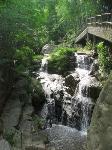
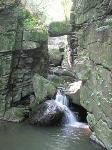
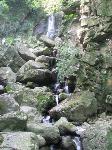
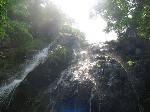
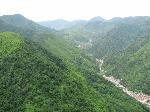

 Copyright © 1998-2025 All rights reserved.
Copyright © 1998-2025 All rights reserved.